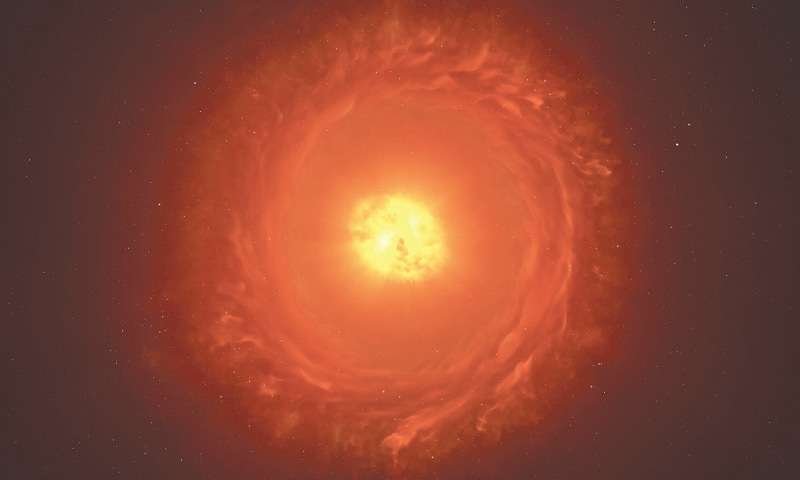In an extraordinary achievement, scientists have successfully captured the first-ever zoomed-in image of a star beyond our Milky Way galaxy. This remarkable breakthrough has revealed a blurry image of a dying giant star, WOH G64, located in the Large Magellanic Cloud (LMC), a neighboring galaxy to our own. This marks a historic moment in the field of astronomy, allowing scientists to study a dying star in much greater detail than ever before.
Introduction: A Leap in Astronomical Observation
For centuries, astronomers have been observing stars from great distances, studying them through telescopes that have allowed us to understand their properties. However, capturing a close-up image of a star outside of our galaxy was once considered an insurmountable challenge. The technology required to achieve such a feat has only recently become available, and this discovery opens a new chapter in our ability to study distant stars, particularly dying ones like WOH G64.
The Star WOH G64: A Giant Red Supergiant
WOH G64: A Behemoth Star
WOH G64 is a red supergiant, a class of star that represents some of the largest and most massive stars in the universe. These stars are known for their immense size and their eventual fate of exploding into a supernova. WOH G64, located approximately 160,000 light years from Earth, resides in the Large Magellanic Cloud (LMC), a satellite galaxy that orbits our Milky Way. It is roughly 2,000 times bigger than our Sun, which makes it an exceptional target for astronomical study.
Red Supergiants and Their Final Stages
As red supergiants like WOH G64 near the end of their lives, they expand outward, shedding their outer layers. This process leads to a dramatic increase in size, making these stars visible across vast distances. However, their final stages are marked by a cataclysmic end—these stars eventually explode in a supernova, releasing immense amounts of energy and dispersing material into space.
The study of these stars is critical for understanding the life cycle of stars and the formation of elements that contribute to the building blocks of new stars, planets, and even life itself.
Technological Breakthrough: GRAVITY and the Very Large Telescope
The Role of the Very Large Telescope (VLT)
The Very Large Telescope (VLT), operated by the European Southern Observatory (ESO) in Chile, is one of the most advanced astronomical instruments in the world. It consists of four individual telescopes, each designed to capture light from distant celestial objects. The VLT has already contributed significantly to our understanding of the universe, but capturing a detailed image of a star in a galaxy far from our own required a new leap in technology.
Introduction of GRAVITY
The recent image of WOH G64 was captured using an innovative new instrument called GRAVITY. This groundbreaking technology combines the light from all four VLT telescopes to create an incredibly detailed view of distant objects, allowing astronomers to study them in much greater detail than traditional telescopes.
GRAVITY works by employing interferometry, a technique that merges the light from multiple telescopes to act as one giant telescope. This provides an unmatched resolution, allowing scientists to see objects that were previously beyond reach.
The Zoomed-in Image of WOH G64
Using GRAVITY, the team of astronomers was able to take the first-ever zoomed-in image of WOH G64, capturing it in more detail than ever before. The image shows the star as a blurry, bright yellow object within an oval-shaped outline, surrounded by a large cocoon of material. This material is believed to be ejected from the star as it nears the end of its life.
The Discovery: An Egg-Shaped Cocoon
What the Image Reveals
Keiichi Ohnaka, an astrophysicist at Chile’s Andres Bello National University, played a leading role in the discovery. He explained that the image revealed an egg-shaped cocoon surrounding the dying star, which could hold significant clues about the star’s imminent explosion. This cocoon is likely made up of material being ejected from the star as it undergoes drastic changes before its eventual supernova.
The discovery of this cocoon is particularly exciting for astronomers. It provides them with a rare glimpse into the final stages of a star’s life, offering a unique opportunity to study the processes that lead to the formation of a supernova. Researchers hope that further observations of WOH G64 will help them understand the mechanisms behind these catastrophic events, which are key to understanding how elements heavier than iron are created in the universe.
The Dimming of WOH G64
An interesting and unexpected aspect of the research is the fact that WOH G64 has been observed to dim over the past decade. This change in brightness was noted by the team, who have been studying the star for several years using different instruments. The dimming could indicate that the star is undergoing significant changes as it prepares for its explosive end. It also raises intriguing questions about how dying stars behave in the final stages before they explode.
Implications for the Study of Supernovae and Stellar Evolution
Supernovae and Stellar Recycling
The explosion of a red supergiant into a supernova is one of the most energetic events in the universe. The material released during a supernova can enrich the surrounding space with heavy elements, which are crucial for the formation of new stars, planets, and even life. By studying stars like WOH G64, scientists hope to gain deeper insights into the processes that govern these stellar explosions.
The Role of Interferometry in Modern Astronomy
The success of GRAVITY in capturing the image of WOH G64 represents a major advancement in interferometric techniques. These methods have been used in the past to study stars and galaxies, but combining the light from multiple telescopes to create a single, high-resolution image is a technological breakthrough. As interferometry continues to evolve, it will allow astronomers to study even more distant stars, potentially revealing the secrets of the universe’s earliest moments.
The Future of Stellar Observation: What’s Next?
Expanding Our Understanding of Distant Stars
With the successful capture of the zoomed-in image of WOH G64, astronomers are eager to apply the same techniques to other distant stars. As technology improves, it is likely that we will be able to study even more stars in detail, revealing new information about the life cycles of these massive celestial objects.
The Search for Other Dying Stars
Astronomers are already planning to study other dying stars in galaxies beyond our own. By observing the various stages of stellar evolution, they hope to gain a deeper understanding of the processes that drive the formation of new stars and the creation of elements necessary for life.
FAQs
1. What is a red supergiant star?
A red supergiant is a massive star that has expanded into a giant size as it nears the end of its life. These stars are among the largest in the universe and will eventually explode as a supernova.
2. How far is WOH G64 from Earth?
WOH G64 is located approximately 160,000 light years from Earth in the Large Magellanic Cloud, a neighboring galaxy to the Milky Way.
3. What is the GRAVITY instrument?
GRAVITY is a new instrument used to combine the light from four telescopes, allowing astronomers to capture high-resolution images of distant stars and celestial objects.
4. Why is the discovery of the cocoon around WOH G64 important?
The discovery of the egg-shaped cocoon around WOH G64 provides valuable insights into the processes occurring before a supernova, which could help scientists understand the creation of heavier elements in the universe.
5. How does interferometry help in studying distant stars?
Interferometry combines the light from multiple telescopes to create a single, high-resolution image. This technique allows astronomers to study distant stars with unprecedented detail, revealing new information about their properties.
Conclusion: A New Era in Astronomical Observation
The achievement of capturing a zoomed-in image of a dying star outside of our galaxy marks a significant milestone in the study of the universe. As technology continues to advance, astronomers will be able to observe distant stars and supernovae in greater detail, offering new insights into the life cycles of stars and the origins of the elements that make up our universe.



